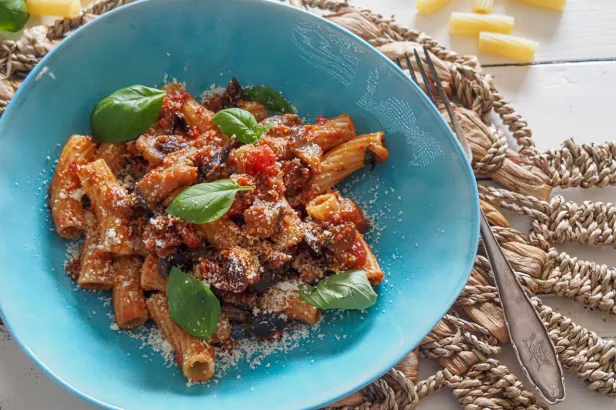Pasta alla Norma | Sicily’s Iconic Pasta Dish

How to prepare the flavourful Sicilian pasta dish that has become a favourite all over the world.
How can it be September already?
Though it is still officially summer, the transition into fall is already quite evident over here. Not only is the sunlight already taking on a much softer colour and temperatures are lower. The new harvest is also starting to appear at farmstalls, with pumpkins becoming more abundant with each day passing.
And yet, I am not ready to let go of summer altogether.
So, the other night I decided to make the most of the last warm evenings and have a large plate of my favourite pasta dish on the patio. Which, like always, brought back memories of glorious summer evenings spend in Sicily, where the dish originates.
It’s no surprise the dish is a local favourite for Sunday lunches or family gatherings and celebrations.
The history of Pasta alla Norma
This classic Sicilian pasta dish was named after a famous 19th century opera composed by Catania native Vincenzo Bellini. As the story goes, a Sicilian writer being served the dish proclaimed it to be absolutely ‘norma’. At the time, it was a term used by locals to describe something outstanding. Which in turn is believed to go back to Bellini’s opera Norma, indeed perceived as an outstanding piece of art.
However, the name aside, the origins of the dish are likely going back much longer. It incorporates ingredients produced on the island for centuries. Tomatoes made their way to Sicily during the 16th century from the Americas, eggplant was brought to the island in the 9th century by the Arabs, and basil came to the Mediterranean via the old spice route from India. Meanwhile, ricotta salata, a dried and salted version of the classic soft ricotta cheese, goes back to the local farming traditions.
What wine to pair with Pasta alla Norma
As usual, what grows together goes together. Pair this Sicilian icon with a wine from the island. It will work well with a dry local white wine like Catarratto or Grillo which perfectly complement the richness of the dish.
However, my favourite wine with Pasta alla Norma is a fruity red Nero d’Avola. It is a fantastic wine to balance the rich flavours of the dish. Alternatively, a Sangiovese from Tuscany will be a fantastic alternative.
How to make Pasta alla Norma, the iconic dish from Sicily
This hugely popular Sicilian pasta dish is easy to prepare. Locally it is mostly served using rigatoni pasta, a short thick type of pasta with a hole in the middle is the perfect shape to scoop up the delicious, meaty-like (albeit vegetarian) pasta sauce.

Although Sicilians will not agree (and likely a range of other culinary geeks either), you can easily substitute the ricotta salata with freshly grated pecorino should you not be able to source the right ricotta at your place. It will change the texture and flavour from the traditional dish, but you will still end up with a delicious version of the classic Pasta alla Norma.
Serves 4
400 g rigatoni or penne
400 g canned tomatoes
200 g ricotta salata (alternatively 30 g finely grated pecorino)
2 medium sized eggplants
2 garlic cloves, finely minced
a handful fresh basil leaves, chopped
salt and pepper
2½ tablespoons olive oil
200 ml sunflower oil for frying
1 tablespoon mild balsamic vinegar
½ teaspoon sugar
freshly grated pecorino and few more basil leaves to serve
Cut eggplants into 1cm sized cubes and sprinkle with abundant salt. Place into a sieve and let drain for about one hour. This will remove excess moister and bitterness.
Rinse the eggplant under cold water, drain and pat dry using kitchen paper.
In a large bowl, mix eggplant with ½ tablespoon olive oil, salt and pepper.
In a large saucepan, heat the sunflower oil over high heat. Add eggplant mixture and fry until golden brown, around 8 to 10 minutes. Remove the eggplants and set aside.
Drain the residual oil from the pan then heat two tablespoons of olive oil over medium heat. Add minced garlic and fry until fragrant. Add tomatoes, vinegar, sugar, ½ teaspoon salt and a pinch of black pepper. Let simmer for 20 minutes over low heat until the sauce starts to thicken. Stir occasionally.
In the meantime, prepare the pasta according to instructions.
Add eggplant and basil leaves to the tomato sauce.
Transfer the pasta to the saucepan without draining, using a slotted spoon. Mix until well incorporated. If needed, add some pasta water to loosen the sauce. Mix in the ricotta or pecorino.
Serve topped with freshly grated pecorino and additional basil leaves.